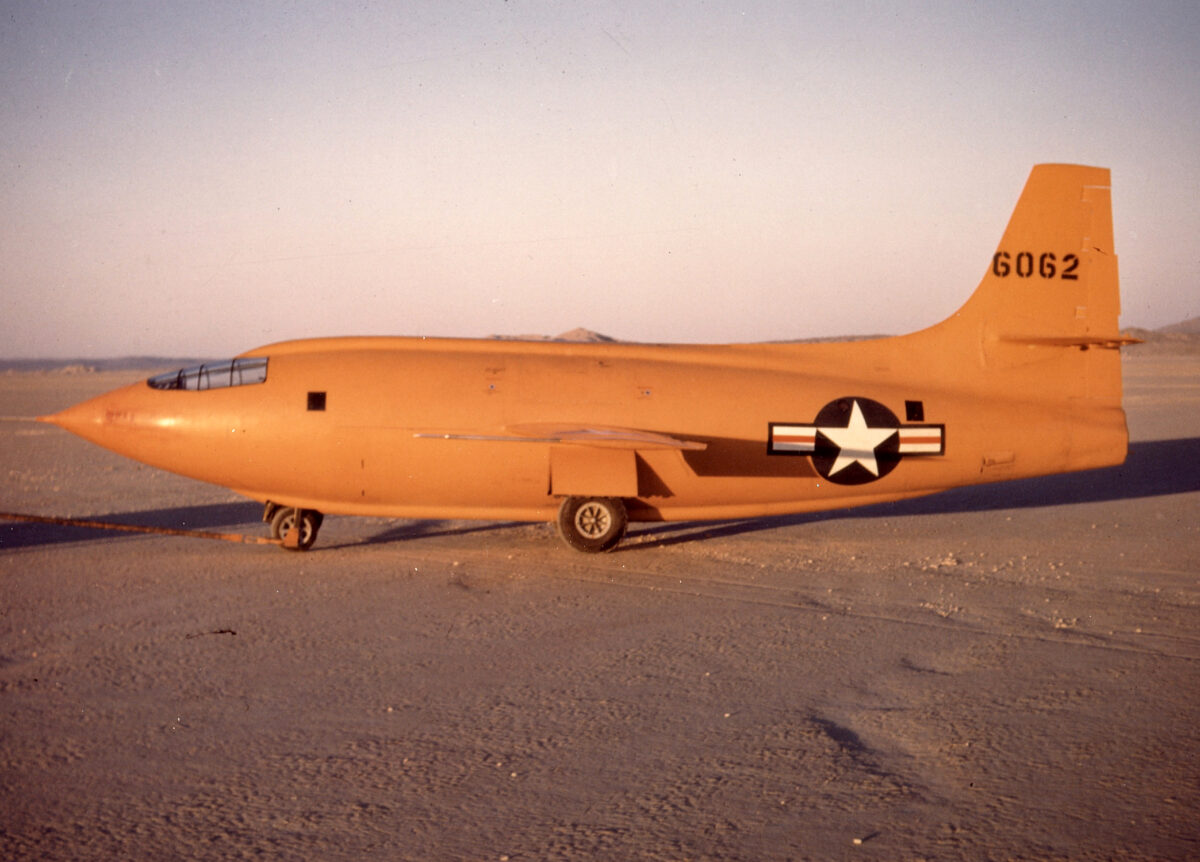The first supersonic flight would not have been possible without the help of countless support personnel, including the man who oversaw the project and piloted the X-1’s B-29 mother ship.
During the past 70 years, numerous books, articles, documentaries and movies have told the story of how U.S. Air Force pilot Chuck Yeager broke the sound barrier in a Bell X-1 on October 14, 1947. But Yeager was far from alone in his pursuit of that historic milestone. Scores of other individuals who contributed to the success of the project have gone largely unnoticed by the general public. They were the Bell engineers and mechanics, the ground crew and the men who carried that orange beast into the sky. Without them, the world would never have heard of Yeager.
America’s first rocket-powered research plane, the X-1 was designed to push the unknown limits of high-speed and high-altitude flight with a superbly designed airframe and liquid-fueled rocket motors. In March 1945, the U.S. Army Air Forces contracted with Bell and the National Advisory Committee for Aeronautics (NACA) to develop the XS-1 (its original designation) and fly it up to and beyond the transonic “barrier.”
The huge B-29 Superfortress was the only aircraft then capable of lifting a fully fueled X-1 to its launch altitude of 25,000 feet. Bell extensively modified Superfortress serial no. 45-21800 to accommodate the X-1, removing the bulkhead between the bomb bays, the bay doors and large sections of the fuselage for the rocket plane’s nose, wings, high tail and stabilizer. Removing so much of the bomber’s hull reduced structural integrity, so a steel longitudinal spar was installed through the centerline. To eliminate glare from the polished aluminum skin and provide a highly visible reference point for the X-1 pilot, the entire underside of the B-29 was painted black.
The rocket plane, painted bright international orange, was hung from a standard D-4 bomb shackle, which could be released by the B-29’s copilot. A retractable ladder allowed the X-1 pilot to descend and enter the tiny starboard hatch. He and the flight engineer were protected from the icy 250-knot wind blast by a thick shield.
The first tests were conducted by Bell pilots and engineers at Pinecastle Army Air Field in Florida. In the spring of 1946, the entire project moved to Muroc Army Air Field in California’s Mojave Desert. Adjacent Rogers Dry Lake had 65 square miles of flat natural runways and plenty of space for emergency landings.
At Pinecastle, a pit had been dug into the ramp for the X-1 to be raised into the bomber, but it was poorly designed. After the move to Muroc, some engineers proposed using a heavy crane to lift the 70,000-pound B-29 over the X-1. Saner heads prevailed, however, and an improved pit was dug for the X-1.
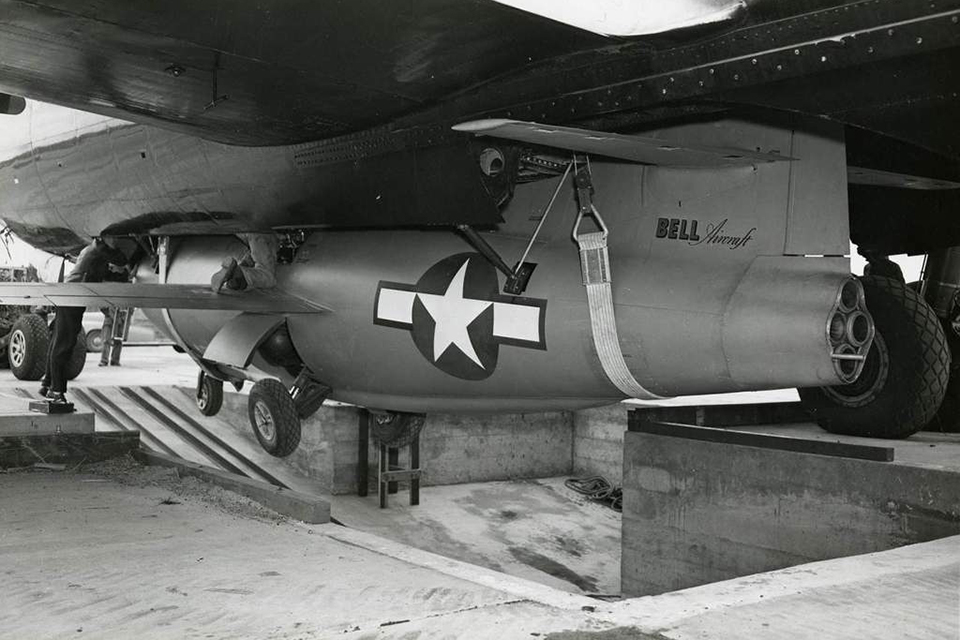
Bell and the NACA began powered test flights at Muroc in late 1946. The NACA was in no hurry, and by early 1947 the X-1 had only reached .84 Mach. But the Army Air Forces wanted it done as quickly as possible in order to gain an advantage over the Soviet Union in the development of high-speed military aircraft. As the program crept closer to its goal, Bell’s chief test pilot, Chalmers “Slick” Goodlin, encountered buffeting and loss of elevator effectiveness as he approached .86 Mach. Goodlin allegedly demanded an exorbitant pay bonus to take the X-1 past Mach 1, prompting the AAF to officially take over the project on June 30, 1947.
That was how Major Robert L. Cardenas, head of the AAF Technical Base’s Bomber Test section at Wright Field in Ohio, came to be called in front of Colonel Albert Boyd, head of Flight Test. Cardenas, now 98, had a sterling career in both Army khaki and Air Force blue.
“Colonel Boyd said, ‘Major, we’re taking over the sound barrier project from the NACA,” remembered Cardenas. “I’ve already selected Captain Yeager as pilot, Lieutenant Bob Hoover as backup and Captain Jack Ridley as flight engineer and copilot.’ He explained I would be the B-29 commander and in overall charge of the project, and he wanted it to be done ‘progressive and brief.’”
Boyd, known throughout Flight Test as a superb pilot and leader, handed Cardenas a handwritten note. “That note repeated what he’d just told me. The key words were ‘progressive’ and ‘brief.’”
Cardenas said he had met Yeager, Hoover and Ridley, but had never worked closely with any of them. “Chuck and Bob were both in the fighter section, so we didn’t have much contact. But after we flew out to Muroc we got along fine. Hoover was an outstanding pilot, and Ridley was a really nice guy who was one of the best flight engineers I ever met.”
Philip Kaufman’s 1983 box office hit The Right Stuff, based on Tom Wolfe’s book, tells a highly apocryphal version of the sound barrier saga. Cardenas and Bell engineer Dick Frost are not even mentioned, while Ridley is portrayed as a laid-back, gum-dispensing sidekick to Yeager. But the reality is far more interesting. Jackie “Jack” Ridley was one of the brightest engineers in the Air Force in 1947. He had been a star pupil of the brilliant Caltech aerodynamicist Theodore von Kármán. His folksy wit led many to underestimate his razor-sharp mind. Yeager, who lacked an engineering background, relied heavily on Ridley to understand the aerodynamic factors involved in breaking Mach 1. This not only helped ensure success, but saved the pilot’s life more than once. Frost was Bell’s best engineer on the X-1. His innate familiarity with the rocket plane and its systems was crucial to the success of the project.
“Jack Ridley was almost a twin to Dick Frost,” said Cardenas. “They were from different backgrounds, but they seemed to think exactly alike. Frost handled all the direct hardware and modifications to the X-1 after the Air Force took over.”
From August 6 until October 12, Cardenas and his team took Yeager and the X-1 up for three unpowered and eight powered flights, each one moving closer to the goal of Mach 1. The flights were always made in the early morning so Yeager would not have the sun in his eyes when he landed on the lake bed.
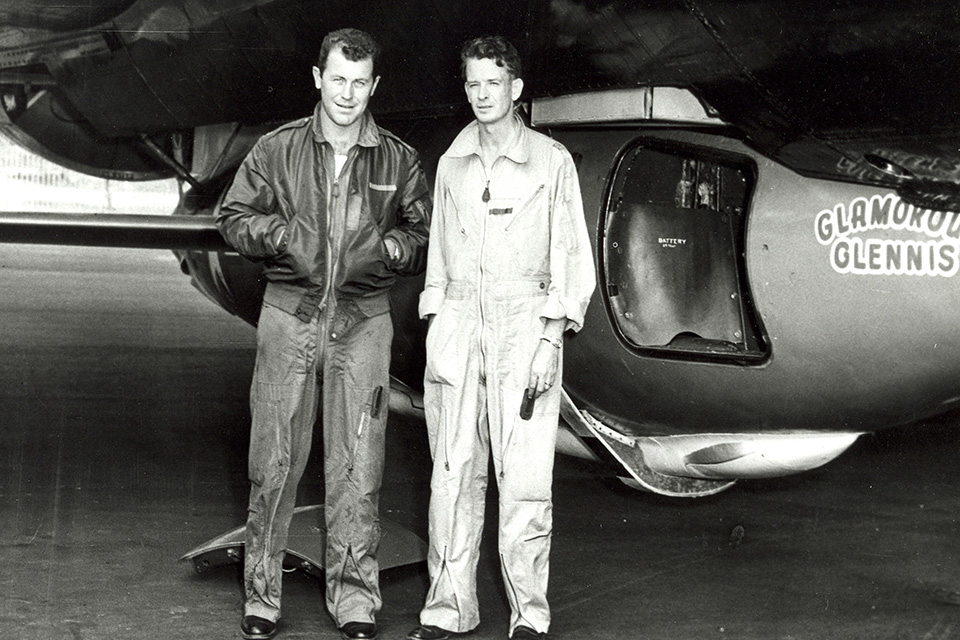
On the night before each flight, liquid nitrogen, used to drive the X-1’s fuel pumps and controls, was pumped into the 14 spherical tanks. Then the aircraft was backed down into the specially shaped pit. Cardenas steered the B-29 over the pit, guided by signals from crew chief Jack Russell and the other ground crew. When the bomb bay was directly over the orange X-plane, heavy straps were slung under it for hoisting.
Russell was a skilled and dedicated Bell mechanic, responsible for keeping the X-1 maintained and its XLR11 rocket engine in working order. In short, he made sure the X-1 was ready to fly. “Without Jack Russell, we would not have made it to Mach 1,” Cardenas said.
Before dawn the B-29 was towed to the fueling facility, where a modified tanker filled the X-1 with 3,000 pounds of liquid-oxygen and ethyl-alcohol fuel. Time was of the essence, as the LOX began to boil off immediately, forming a layer of frost on the fuselage. While Russell supervised the fuel loading, Cardenas and his crew conducted the preflight check and pulled the B-29’s propellers through before starting the engines.
Cardenas and copilot Ridley taxied the B-29 out to the runway, with Yeager sitting on an empty apple crate behind the pilot. Cardenas said that lifting the B-29 into the air with the 13,000-pound X-1 on board was a delicate operation. “The X-1’s belly hung less than two feet off the ground,” he explained. “I could only lift the nose wheel about eight inches off the runway to keep from scraping the X-1’s tail. I watched the horizon through the nose. It was a matter of feeling the air and using my experience to pull back on the yoke just enough to generate lift.”
At 12,000 feet Yeager, with Ridley behind him, crawled through the hatch to the unpressurized bomb bay. The air temperature was well below zero, and the airstream howled in the confined space. Clad only in a flight suit and leather jacket, Yeager stepped onto the ladder fitted to the right side of the bomb bay, then wormed his way into the X-1’s hatch outside the B-29. Ridley remained on the ladder as the X-1 door was lowered by another crewman. He helped Yeager fit it into place.
The next steps were to disconnect the X-1 from the B-29’s power, and then check to make sure its internal battery was working properly. After a radio check to link Yeager with the B-29 crew, the first-stage nitrogen regulator was used to pressurize the LOX and fuel tanks.
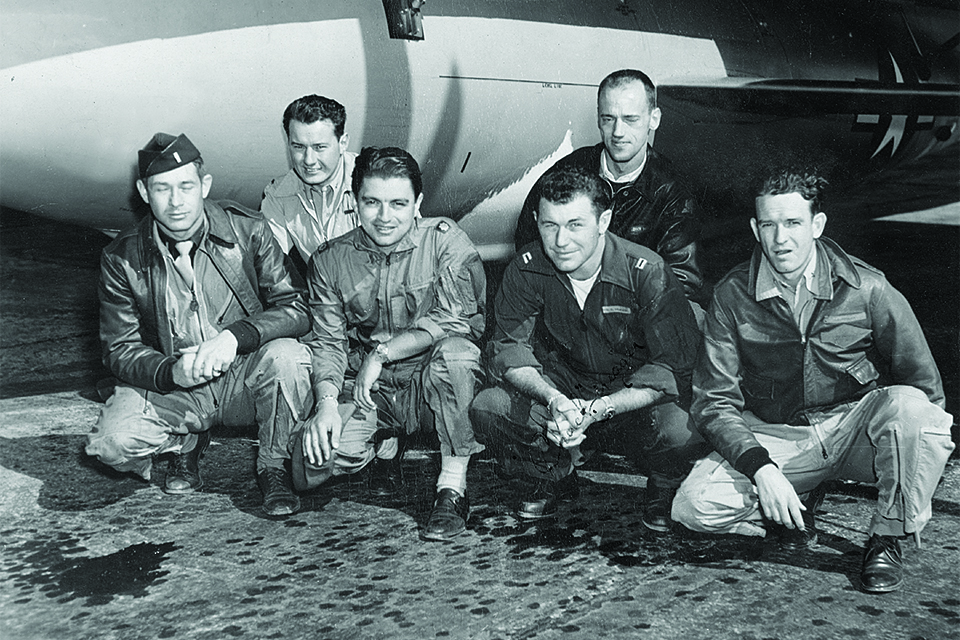
Cardenas climbed the B-29 to 25,000 feet, keeping close enough to Rogers Dry Lake for Yeager to glide to a safe landing if the X-1’s rocket engine failed. “I made a long turn until we were about 40 miles out,” Cardenas said. “Then I lowered the B-29’s nose and advanced the throttles to 250 knots indicated airspeed.”
When all was ready Cardenas began his verbal countdown from 10 to zero. “I held up my hand for Ridley to get ready. When I reached zero I dropped my hand and he pulled the release handle.”
Once Yeager was free of the B-29 he was on his own but for the two Lockheed F-80 chase planes, piloted by Frost and Hoover. Frost flew low chase for the initial drop in case anything went wrong, which it often did. As an experienced test pilot and one of the first men to fly the X-1, he knew how to fix or deal with most problems.
Hoover, today remembered as one of America’s finest pilots, flew high chase about 10 miles ahead of the B-29 to give Yeager an aiming point. After the X-1’s four rocket chambers ignited, it streaked past Hoover like he was standing still.
Meanwhile Cardenas and Ridley circled in for a landing. “Once we dropped Chuck all we could do was watch his white contrail streak away into the blue sky,” said Cardenas.
Every flight presented challenges, and one nearly ended in disaster when Ridley pulled the release and the X-1 failed to drop free. After conferring with the copilot, Cardenas told Yeager to jettison the X-1’s fuel and climb back into the B-29. “He could only dump about half the fuel,” recalled Cardenas. “I had to make a nearly perfect three-point landing to keep the X-1 from striking the ground.”
During one flight Yeager’s windscreen iced over so badly he couldn’t see, so Dick Frost talked him down to a safe blind landing on the lake bed. The icing problem persisted until the indispensable Jack Russell came up with a simple solution. Before each flight he applied a coating of Drene shampoo to the inner surface of the canopy. It solved the problem and they continued to use it even after the Air Force found a chemical that cost $18 a bottle.
On the seventh powered flight, in early October, the team hit a real barrier that threatened to bring the entire program to a halt.
“Chuck lost elevator effectiveness at .92 Mach,” Cardenas explained. “We all sat down in the hangar and talked about what to do. Frost said, ‘Well Bob, I think that shock wave is getting close to the elevator hinge and blanking it out. But we built the horizontal stabilizer so it could be unlocked to be raised and lowered. I can run it into the hangar and put in a vertical worm gear to be operated with the nitrogen system. That would let Chuck adjust it in flight.’ I turned to Ridley and asked him, ‘Jack, do you think that tail is going to fly off the first time Chuck tries to adjust it in flight?’ Jack said, ‘I don’t know, Bob.’”
This put Cardenas as project manager in a difficult position. He had to decide whether to allow Frost and Russell to modify the X-1’s stabilizer and run the risk of it tearing off at .92 Mach. If he followed normal protocol, he would have sent the X-1 back to Wright Field for a full structural analysis by a team of Bell and Air Force engineers. That would take weeks. But he had an ace in the hole. “I had that note from Colonel Boyd,” he said with a smile. “He wanted the project done ‘brief.’ So I told Dick, ‘Run it into the hangar and do it.’ I took the responsibility. I knew Dick and Jack would do their best to make it work.”
On the next flight, as Yeager approached .92 Mach the shock waves slammed into the elevator, rendering his pitch controls useless. But Dick Frost’s marvelous modification saved the day as Yeager set the stabilizer to two degrees down and regained control. At .94 Mach the buffeting ceased entirely.
The team’s ultimate goal was within reach, but Cardenas soon had another serious concern on his mind. “Two nights before we were going to try and break Mach 1, I got a call from someone. I don’t know who it was, but the caller said that Chuck had run into a fence on his horse out at Pancho’s [Pancho Barnes’ Happy Bottom Riding Club] and broke two ribs. ‘I know what he has to do,’ the caller said, ‘and I know you’re in charge. I thought you should know.’ From that moment on I had a lot to think about. Should I pull Chuck off the flight and give it to Hoover? Bob was a terrific pilot but I owed it to him to let him have a couple of powered flights before trying to go supersonic. But Boyd wanted it done brief. It was on my mind for two days. If I let Chuck fly and something happened to him, it would be my fault. My neck was stuck out a mile.”
Yeager was unaware that Cardenas knew about the broken ribs. “Chuck never said anything,” recalled Cardenas, “and Hoover also kept quiet.”
There was little doubt Yeager could make the Mach 1 attempt even with broken ribs. But after climbing into the X-1, he’d still have to close and lock the hatch, which would require some heavy lifting and leverage.
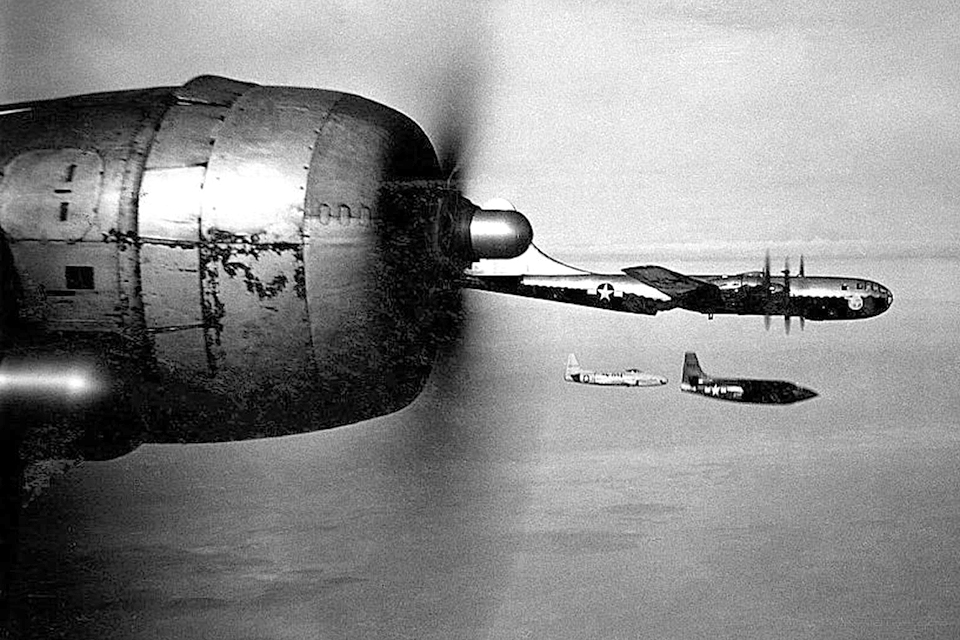
Jack Ridley came up with a simple solution, using a broom handle. This has become one of the legends surrounding the X-1 story. In The Right Stuff, Ridley cuts off a piece of the broom being used by Russell.
“The part in the movie where Ridley cuts off Jack Russell’s broom is misleading,” commented Cardenas. “Russell was in charge of keeping the X-1 maintained. And that also meant keeping it clean. He was a fanatic about keeping the sand and dust out of the hangar. He was constantly sweeping and cleaning. That X-1 was his baby. But in the movie his real role is not even mentioned.”
On the night of October 13, Cardenas, having weighed every factor for success or failure, decided to let Yeager make the attempt to break Mach 1. But the tension among the Air Force personnel, the NACA scientists and the Bell engineers was palpable. The morning of October 14 was no different from the routine that began at Pinecastle nearly two years earlier, with one major exception.
“I was going through our usual preflight check when an F-80 landed on the base,” Cardenas remembered. “I went over to see who it was. Down comes Colonel Kendall Paul, one of Boyd’s deputies. I asked him what he was doing there and he said, ‘Bob, I’m here to be your copilot today.’ I knew right away that somehow Boyd had learned about Chuck’s broken ribs. He sent Paul out to be the one who actually dropped the X-1. Boyd knew my neck was stuck out a mile. He took the responsibility. That’s the kind of leader he was. He backed up his men.”
Cardenas and his crew carried the X-1 to 25,000 feet. Colonel Paul pulled the release and the rocket plane fell free.
That day the sky over Muroc was rocked by a sonic boom. “We heard that his Mach meter had fluctuated off at Mach 1.06,” said Cardenas. “Chuck had broken the barrier and that was great, but he was only one man on a great team. Chuck was the one who did it, but he was far from alone in the sky.”
Today the sky over the Air Force Test Center at Edwards AFB echoes with the sounds of advanced military and research aircraft. The lake bed still serves as an airfield, marked by long lines of runways and taxi areas. The special pit for the X-1 is still there, an odd remnant of a vanished era. But the men who made the first leap into the supersonic age are mostly gone. Jack Ridley died in a plane crash in Japan in 1957. Today Edwards’ Mission Control Center is named in his honor. Dick Frost went on to develop escape systems and other high-speed aircraft. He died in 1996. Jack Russell died in 1997. Besides Chuck Yeager, only Bob Cardenas, now a retired brigadier general living in San Diego, carries the torch of mankind’s first foray into the supersonic realm.
Frequent contributor Mark Carlson is the author of Flying on Film: A Century of Aviation in the Movies 1912-2012 and The Marines’ Lost Squadron: The Odyssey of VMF-422. Further reading: Bell X-1, by Peter Davies; Supersonic Flight: Breaking the Sound Barrier and Beyond, by Richard P. Hallion; and Chasing the Demon, by Dan Hampton.
This feature originally appeared in the May 2019 issue of Aviation History. Subscribe here!

